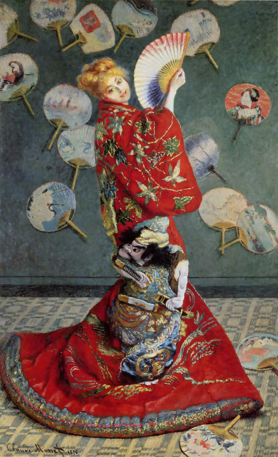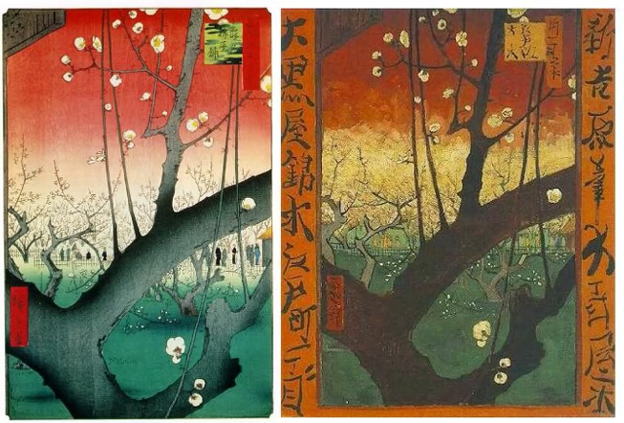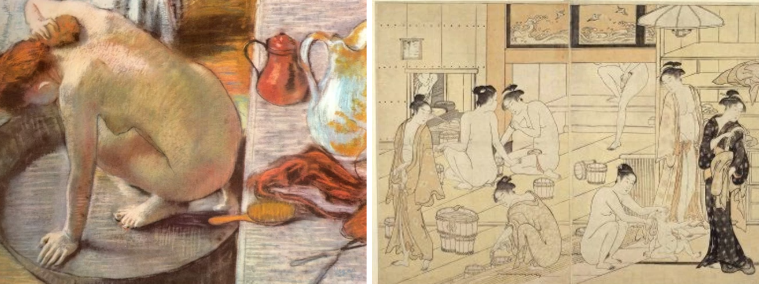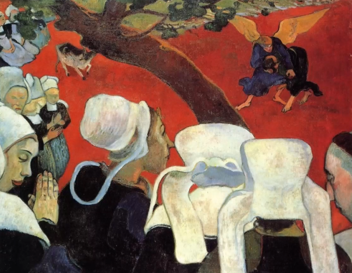Lecture 10: Japonisme: The reception of Japanese culture in Europe in the late 19th century
1/11
There's no tags or description
Looks like no tags are added yet.
Name | Mastery | Learn | Test | Matching | Spaced |
|---|
No study sessions yet.
12 Terms
Key Ideas
To Europeans (3)
To Japanese (2)
Japonisme (1860s-1890s) in the West as a dense brew of appropriation, commerce, & respect (The New York Times), involving reciprocal artistic influences between Japan and the West.
To Europeans:
Increasingly industrialised, European art world was seeking new direction
Fascinated by exotic appeal & artistic novelty of Japan
Projection of a mythical image of an innocent, idyllic, pre-modern society
YET web of preconceptions & prejudices forming the Western perception of Japanese art
Undercurrent of superiority towards Japan as an exotic other
Projection of European artistic hierarchies: Japanese art as purely decorative
European utilisation of Japanese artistic sources = progressive, Japanese use of European styles = copying
To Japanese:
Wanted to catch up w/ the Western nations & achieve parity w/ them
Looked to the West as a model for its own industrialisation
Fuelled its industrialisation through:
(1) Foreign export
(2) Participation in international fairs
Often assumed to have played a passive role, BUT carefully controlled the image of Japan
Japonisme
Historical context
Historical context
1860s-90s
During European Modernism
1st coined by French art critic Philippe Burty
‘The study of the art & genius of Japan’
Art historian Klaus Berger: ‘the recognition, admiration, adoption, & reinterpretation of the Eastern way of seeing’
Tremendous fascination for things Japanese that swept Europe & America
Influenced Western art & design
Timeline
1500s-1920s
1500s
A few European merchants & missionaries had already made their way to Japan
1630s-1853
Japan’s fears of foreign influence
Rulers expelled all resident Europeans
Contact w/ the outside world was severely restricted
Only direct link w/ Europe was through a small no. of Dutch traders working for the Dutch East India Company
Trickle of Japanese artefacts into Europe
Made for export
BUT still made quite a disproportionate impact in Europe
Became highly prized status symbols in European aristocratic circles
Little distinction in Europe between Japanese & Chinese products
1853
Western powers forced Japan to open up to international trade
Trade treaties signed between Japan & the USA, Russia, Britain, France, & the Netherlands (5)
Surge in trade of Japanese art
Esp. England & France
Travellers to Japan increasingly brought back souvenirs of their own
Much greater volume of Japanese objects in circulation
= fascination w/ Japan surged, ‘discovery’ of Japanese art
2nd half of the 1800s
Great international exhibitions began to be organised
Highly successful, enormous audience figures
Further increased awareness of Japanese art in the West
In response to this enthusiasm:
Specialist dealers selling Japanese artefacts sprang up throughout Europe & America
Japanese export industry flourished
Eagerly pursued a policy of industrialization
Mass producing exotic goods for export to the West
1862: ‘Japanese Court’ - International Exhibition
1st time that Japanese art was seen by a wide audience in Europe (>6 million visitors)
Hugely successful
Majority of objects was curated & exhibited by Rutherford Alcock
1st British diplomatic representative to live in Japan
Enthusiastic collector of Japanese art
BUT a group of Japanese envoys who toured the exhibition considered the selection completely unrepresentative of Japan
1867: Paris International Exhibition
1st time the Japanese government showed their own objects
Enormous audience figures (~7 million visitors)
After this in 1868, Japan entered Meiji period
A revolution in Japan resulting in the overthrow of the Shogun (military ruler) and restoration of power of the emperor Meiji
Japan attempted to catch up w/ the Western nations & achieve parity w/ them
New Meiji gov. immediately initiated a major campaign for the modernisation of Japan along Western lines
Opened up opportunities for novel forms of artistry
E.g. wearing of swords & samurai were banned, metalworkers adapted their skills for the export market (e.g. decorative metalwork)
Realised that world fairs offered an ideal opportunity to establish Japan on the international stage
(1) To demonstrate the quality & uniqueness of Japanese products abroad
ALTHOUGH Japanese industrial products were still no match for post-industrial revolution Western counterparts
(2) To learn about the latest Western technology
(3) To promote exports → acquire foreign currency needed to implement modernisation program
Economic interests
= involvement in these exhibitions became official Japanese policy, participated in many ⭐
1876: Philadelphia Centennial Exhibition
1st time that Japanese art went to America
The official English language report accompanying the Japanese catalogue (created by the Japanese government) expressly underlined the similarities between:
(A) The medieval European artisan
(B) His Japanese counterpart
In being both artist & artisan
Late 1800s
Gap between fantasy & reality widened
Japan did slowly catch up with the West
Developed both industrially & militarily
Western nations began to get quite uneasy
Dismissive of Japan’s achievements: merely hollow imitations of the accomplishments its betters
Fear that the charm of Japanese art would be lost once the country came too much in contact w/ the West
Would have to receive ‘barbaric copies of our own works’
By the 1920s
Japonisme craze faded away
No longer novelty
Preconceptions & Prejudices of Japanese art (3)
Even at the peak of Japonisme, there was always an undercurrent of superiority towards Japan as an exotic other
Anna Jackson: ‘Ultimately, the enthusiasm for Japan and the admiration for the lives of the supposedly simple, innocent Japanese people was entirely dependent on the unshakeable belief of the ultimate superiority of Western civilisation’
Patronising tone in Western commentaries: ‘quaint’, ‘curious’
E.g. Christopher Dresser (British designer in the Anglo-Japanese style): ‘Japanese shapes certainly often display quaintness rather than grace’
The Japanese’s celebrated love of nature as ‘childlike’, primitive
Projection of European artistic hierarchies on to Japanese art
Japanese art as purely decorative, not able to appeal to deep intellectual/political feeling
A purely Western construct: vs. in Japan, the terms ‘art’, ‘fine art’, and decorative art’ didnt even exist
Until Japan needed to learn & adopt these terms for participation in world fairs ⭐ (e.g. writing of catalogues)
E.g. comparison of Japan to the European Middle Ages
Artists = artisans
Because Japan’s achievements were most visible in the ‘decorative arts’ rather than ‘fine arts’
Implies that Japan was still only on the 1st stage of artistic progress, lagging behind Western civilisation
ALTHOUGH the Japanese government did reinforce this image of Japan
Chinoiserie
Oliver Impey: ‘The European idea of what the products of the distant lands that came to be known as the Orient/Far East were like, or should be like’
Lumping of all Eastern objects as equivalent
Influences of Japanese Art on Western art
Woodblock prints
‘Pictures of the floating world’ (ukiyo-e)
Depicted scenes from the transient, floating world of the Japanese pleasure quarters
Courtesans, teahouse girls, Kabuki actors
Available cheaply & in large quantities in Europe from the early 1860s
Mostly printed albums & single sheet prints
A time when artists were eager to find a novel form of inspiration
End of Impressionism
Were not considered especially good art in Japan
Mass produced
Highly disposable
BUT were still a revelation to Europeans
Provided novel ways of visualising images
Basic conventions of Japanese art were quite different from Western art
E.g. use of unusual viewpoints
Mount Fuji through a hole in a tree
Bold outlines
Asymmetrical compositions
Strong diagonals
Lack of necessity to place main subject in the foreground
Building up of a picture using strong flat areas of colour
Lack of light & contrast
Delight in animal/plant patterning
Lack of geometric perspective
Use of vertical perspective instead
No fixed vanishing point
= new freedom from imitative/ photographic representation
Influences of Japanese Art on Western art
Development over time
Stage 1: Wholesale inclusion of Japanese props/attire in paintings
One of the earliest stages of Japonisme
Frequent issues: orientalism/cultural appropriation, institutional racism, racialised iconography
E.g. Camille Monet in Japanese Costume (La Japonaise) by Claude Monet (1876)
E.g. Vincent van Gogh
Was the most open about his debt to Japanese art
‘In a way, all my art is founded on Japanese art’
He and his brother Theo collected enormous amounts of Japanese prints
Copied (in oil paint) woodblock prints from his own collection
To investigate the artistic devices of Japanese landscapes
Stage 2: Poses & pictorial conventions from Japanese prints
By the 1880s, knowledge about Japanese art was becoming deeper & more discriminating
Wider variety of Japanese art was becoming accessible + growing numbers of in-depth studies of the subject
Moved many artists towards Japanese pictorial schemes
Flatter compositions; large areas of flat colour
An emphasis on outline
Unusual compositional perspectives
Asymmetry
Cropping
Unexpected figural poses
Bright colours
E.g. Henri de Toulouse-Lautrec, Jane Avril at the Jardin de Paris (1893)
E.g. in Japanese art, human figures were depicted w/ an intimacy that was unknown to Europeans
Natural & spontaneous gestures
Simpler, day-to-day settings > traditionally formal studies
= in the West, developed a new attitude towards the sitter
E.g. The Tub, Edgar Degas (1886)
Stage 3: Adaptation of Japanese artistic conventions to Western artists’ own purposes
Extracting the essence of Japanese art and using it as a springboard for their own creativities
Much more subtle, harder to identify
At this point, the Japanese influence is often second-hand
Encountered through other works of Japan-influenced contemporaries
E.g. The Vision after the Sermon, Paul Gaugin (1905)
Influences of Japanese Applied Arts on Western art
Historical context
Early 19th century
After the Industrial Revolution (ended 1830)
New materials & industrial processes offered exciting possibilities for production
By the mid-19th century
European artists & designers were struggling to cope w/ negative effects of industrialization & demands of mass production
E.g. Brought about the Arts & Crafts movement
To recreate the bygone age of the artist craftsmen
For the improvement of the quality of life & art
Stressed importance of:
Simplicity
Sincerity
A close study of nature
Sought inspiration in the idealised past of the Middle Ages & exotic kingdoms of the Orient
Saw it as a ‘fresh well of art’ uncorrupted by industrialisation
Morally superior to European art ⭐
Influences of Japanese Applied Arts on Western art
Development over time (3 stages + limitations)
Stage 1: Simple incorporation of Japanese motifs
Derived from Japanese prints & decorative arts
Adaptation of designs/motifs
E.g. from the Hokusai Manga
In jewellery, fabric, & wallpaper
E.g. cloisonné jewellery
Linear forms of woodblock prints lend themselves well to the technique of cloisonné enamel (metal wirework containing flat areas of enamel colours)
Stage 2: Usage of Japanese items in daily life
Sometimes changed how objects were used
E.g. Japanese netsuke - carved toggles used to hang things from your belt
E.g. Ornamental textiles
Extremely popular in European homes in late 19th century
Designed for the export market, to be displayed on walls
E.g. Fukusa
Traditionally used to drape over Japanese gifts/as wrapping cloths
Used by Westerners to hang/frame on walls
Stage 3: Reverse Influences
Flow of ideas, visual references & techniques from the West → Japan
2-way influence ⭐
E.g. French cloisonné which had been influenced by Japanese art then had enormous impacts on Japanese cloisonné
Japanese makers were very much aware of the European interest in Japanese art
Deliberately catered to this interest ⭐
Japan DIDN’T play a passive role in Japonisme
E.g. development of artistic textiles
Deliberately mimicked a fine art format (like a framed picture/European tapestry)
Limitations
European manufacturers WEREN’T always able to replicate original Japanese techniques
E.g. lacquer
Traditional Japanese wire cloisonné techniques vs. Western electrode deposition; made cavities in the metal body for enamel to sit in

La Japonaise, Claude Monet (1876)
Historical context
Monet was very interested in Japanese art (esp. prints)
2015: Kimono Wednesdays controversy at the Museum of Fine Arts in Boston
The Museum of Fine Arts in Boston owned the painting
Lent the painting to an exhibition in Japan
A no. of replica kimonos were created by the Japanese sponsors
Japanese visitors were encouraged to try them on as part of the viewing experience
When the painting returned to Boston, these sessions continued
Intended to encourage close engagement w/ the painting
BUT many visitors regarded the event as an offensive stereotyping & exoticising of Asian-Americans
Sparked huge amounts of protests
Analysis
Monet’s wife, Camille
Clothing: a dashing red kimono
Detailed Samurai embroidery positioned near the center of the canvas
Dark hair, stern facial expression, strong grip on sword
Contrasts Camille’s blonde hair, holding a fan delicately & smiling
= emphasises difference between ‘Japanese’ setting & the European woman within it
Holding a fan
In the colours of the French flag
Pose: turned in profile, showing her face turned towards the viewer
Likely inspired by gestures found in traditional Japanese dance
Wearing a blonde wig to emphasise her Western identity (hair is normally dark)
Background: printed Japanese fans hanging on wall, seemingly at random
In particular: red fan to the right of Camille’s raised right hand
Shows a Japanese woman with dark hair, wearing a kimono & traditional hairstyle
Separated from the others w/ a contrasting red background
Face tilted in the opposite direction to Camille’s, with an almost astonished facial expression looking at her European counterpart
Floor: Japanese-style tatami mat
Interpretation
Shows the initial stages of Japonisme: the performance & appropriation of Japanese culture rather than an authentic Japanese environment
Copying & conspicuous use of Japanese props in paintings
In reality, there is very little Japanese about it
Debates over whether the painting was depicting orientalism/cultural appropriation, institutional racism, racialised iconography, representation of minority groups

Vincent van Gogh’s copy of The Flowering Plum Tree in the Kamedo Garden, Hiroshige
Historical context
Van Gogh copied Hiroshige’s print in oil paint
From his own collection of Japanese woodblock prints
To investigate the artistic devices of Japanese landscapes
Analysis
Van Gogh has clearly reinterpreted the image
Altered the relationship between height & width slightly
Closer to the golden ratio
More familiar to Western art
Bright orange framing strips
Contains random, unrelated Japanese characters he copied from another print
In reality: advertise a brothel
Everything is a bit more dramatic & exaggerated vs. Japanese original

The Tub, Edgar Degas (1886)
Historical context
Degas had a copy of the Japanese print on the right in his bedroom
Analysis
Right: women in a day-to-day setting
8 different poses
E.g. coming their hair, playing w/ their children
Left: woman hunkered down in a tub
Body modelled in Western style
Strong shading & contrast
Sense of 3-dimensionality
Aerial perspective in Japanese style
Steep, downward angle past the dressing table
Naturalistic pose in Japanese style
Woman does not look at/acknowledge the viewer
Voyeuristic, as if caught unawares of us as she proceeds about her daily activities
Interpretation
Human figures were depicted w/ an intimacy that was unknown to Europeans
Wide range of natural & spontaneous gestures
= in the West, developed a new attitude towards the sitter

The Vision after the Sermon, Paul Gaugin (1905)
Historical context
Gaugin owned Japanese woodblock prints
Narrative:
Biblical Jacob wrestling with an angel
‘the landscape and the fight only exist in the imagination of the people praying after the sermon’
Analysis
Flat areas of bold colour
Strong outlines
Cropping
Placing of subject to the back
Composition divided into 2 distinct halves by a tree
Separation between reality & the vision
Use of vertical perspective (not geometric perspective)
Subjects further away from us are positioned higher up in the painting
As crowd of women get further away, slopes upward
= sense of dynamism, warped perspective that denotes the vision’s otherworldliness
Juxtaposition of different components to give a flat, patterned effect
Interpretation
Represents the final stage of Japonisme: the understanding of Japanese artistic conventions and adaptation to Western painters’ own creativities